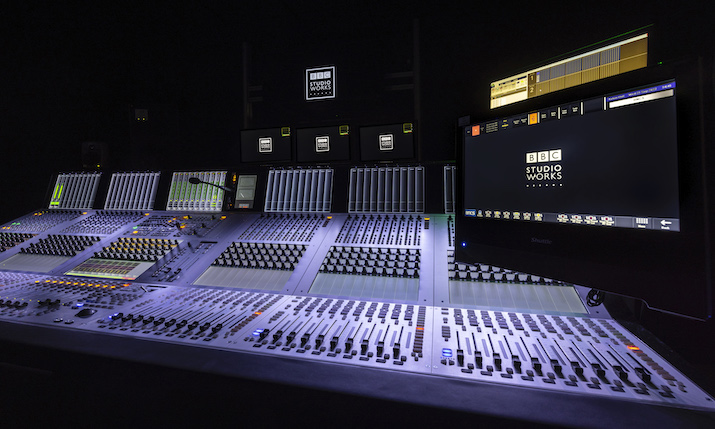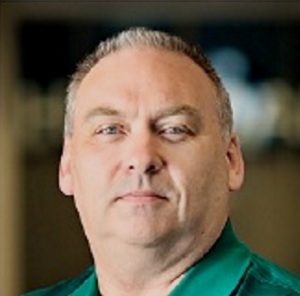Back with a bang: The evolution of Studer continues

A large-format Studer Vista X console has been installed at BBC Studioworks’ Kelvin Hall facility
Credit: Martin Shields
Paul Shorter describes himself as a “veteran newbie”. Prior to being senior product manager at Evertz Audio Solutions, Shorter spent seven years as manager of technical services in the US for Soundcraft Studer. Before that, he spent three years working with large-format mixers as business development manager, broadcast sales and tech support for Harman. He knows his way around a console, but as far as anyone at Evertz is concerned, he’s the new guy.
At the start of 2021 – right in the midst of the pandemic – Evertz announced an asset purchase agreement with Harman International to acquire the Studer brand. The acquisition made a huge amount of noise, but then, there was silence. Not much appeared to be happening. But, much like that famous duck that’s furiously paddling away under the water, there was a lot going on under the surface.
In September 2022 Studer burst back onto the scene with a raft of product launches that seemed like a mark of intent from Evertz to integrate the brand into its wider portfolio… Which is exactly what it was.
The new IP-based Studer products were unveiled as part of Evertz’ efforts to integrate Studer’s technology into its own live production workflows. Studer’s Vista digital consoles and Infinity processing core became part of Evertz Software Defined Video Networking (SDVN) solutions, and IBC saw the launch of both the compact Vista 1 Carbon and the Infinity-ST server core.
New installations started to appear, such as the large-format Vista X console at BBC Studioworks’ Kelvin Hall project which opened its doors in September. In this, Studer’s 75th anniversary year, it feels like things are definitely gearing up. But why the silence?
A help and a hindrance
“The pandemic helped in some ways, but hindered in others,” says Shorter, looking back on a tumultuous few years. “We spent most of 2021 moving production and manufacturing from Europe to Canada, and the pandemic really slowed us down because we couldn’t send people to help.

Paul Shorter, senior product manager, Evertz Audio Solutions
“But it had its benefits. The delay gave us an opportunity to take a step back and look at the best way to integrate Studer into the Evertz family. It gave us some space to look at the bigger picture, and that year became all about how we fit things together.”
Mo Goyal, senior director for international business development, live media production at Evertz, agrees: “The immediate objective was to move manufacturing, but a much bigger focus was to look at where the industry was going. Where are the biggest gains where we can add value and demonstrate the integration of our systems?
“IP was a clear first step. Evertz has been part of the IP transition since the very beginning and so we already have that expertise and experience. The Studer platform didn’t have that history so our first step was to look at how to get the Infinity Core platform into the ST2110 world. Our Magnum orchestration is a unified control system which already operates in that environment and helped us integrate the Studer product line faster.”
The integration has already paid dividends, and Evertz’ messaging at IBC reflected that with the headline news that “new IP-based Studer products have been unveiled… as Evertz focuses on integrating Studer technology into its own live production workflows”.
In addition to the Vista 1 Carbon, the Studer Infinity-ST server core boasted a new CoreLink card audio interface that provides ST2110-30 as well as Studer’s proprietary A-link connectivity. It was a bold statement of intent from the Canadian company.
A head start
Goyal adds: “Evertz used to be more concerned with building the infrastructure to connect all the elements inside production and take that out to playout and distribution. Over the last five years the company has been increasing its technological reach into production. It is part of our strategy to deliver live production toolsets and we identified a gap with the audio component.”
The opportunity to fill that gap with Studer was too good to turn down, and it also gave Evertz, a company with a reputation for innovation in the video world, a head start in the audio market.
“The strength of the Studer brand was part of what attracted Evertz to it,” says Goyal. “On the creative production side the big players are already out there, and creatives already have tools they are comfortable with. Regardless of how advantageous our toolset is, we would be the new kid on the block and operators would remain loyal to the brands they love. Studer helped open some doors to the audio production market, and having Studer back in the broadcast space as part of a group which has never been afraid to innovate was a positive message for Studer’s existing customer base.”
Consoles are not dead
Innovation is something that Studer already has a reputation for. In fact, its Vistonics user interface, which introduced the concept of control knobs on glass, is 20 years old this year.
As the broadcast industry embraces new working models and concepts like the cloud, and as the very concept of mixing consoles undergoes a re-evaluation in the eyes (and ears) of broadcasters, the company is still focused on making the user interface fit the environment. But what is that environment?
“Seven years ago a colleague told me that large-format mixers were dead in the water, and yet seven years later we’re still manufacturing them and there is still a demand for them,” says Shorter. “While there is a definite shift towards making things more compact there are still people who want to grab a handful of faders and have them visible on the surface.”
Goyal agrees: “We’re seeing this on the video side too. Some of the big productions are only going to get bigger, and there are more and more channels to deal with; more cameras, more mics, more audio sources being captured. People need the right tools to manage all of that. The market for these events isn’t going anywhere.

Mo Goyal, senior director for international business development, live media production, Evertz
“But what will be interesting is the next tier in production where more content is being created with smaller teams. They might not be your A Team, but you still want to be able to give them access to the capabilities they need. Younger people coming up in this bracket are more adept with alternative ways of working, such as touch and graphical interfaces. One of the things we demonstrated at IBC was our customisable Vue graphical interface which is now able to work with a Vista console, allowing operators to build control surfaces which work for them.”
Shorter continues: “Making the UI as intuitive as possible will be key for many customers as we move into this new era, and it will be hybrid. People are getting used to touch interfaces, but many people still want some tactile control. We’ve had requests for real faders on what we showed at IBC, so that’s our next step; how do we get some kind of physical control which is scalable so that it fits the environment.”
More to come
Following a period of intense development, and with much more on the horizon, Shorter recognises that the market has changed since Studer was integrated into the Evertz ecosystem. In fact, the Vista 1 Carbon was a reaction to some of those changes, and is a cheeky nod to more to come.
“People are getting used to touch interfaces, but many people still want some tactile control”
“Being part of the Evertz organisation these past two years has been an interesting ride!” he says. “The engineering talent we have access to has opened up so many discussions and given us a different perspective, and there are already new opportunities arising from these internal conversations. This mixed engineering approach is very dynamic; there are things we can move very quickly on, but crucially there are things we can take a longer view on; where are we going to be in three to four years’ time?
“The Vista 1 Carbon is a good example. Its 22 faders with built-in DSP and I/O was a response to the market, but it’s a partial stepping stone for something we are looking to do in the future. I’m hoping that by IBC this year we will have another announcement to make regarding something new for Vista.
“I’m very excited about where we’re going and what we’re doing.”
